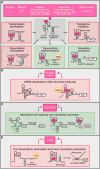A decade of riboswitches
- PMID: 23332744
- PMCID: PMC4215550
- DOI: 10.1016/j.cell.2012.12.024
A decade of riboswitches
Abstract
Riboswitches were discovered in 2002 in bacteria as RNA-based intracellular sensors of vitamin derivatives. During the last decade, naturally occurring RNA sensor elements have been found to bind a range of small metabolites and ions and to exert regulatory control of transcription, translation, splicing, and RNA stability. Extensive biochemical, structural, and genetic studies have established the basic principles underpinning riboswitch function in all three kingdoms of life with implications for developing antibiotics, designing new molecular sensors, and integrating riboswitches into synthetic circuits.
Copyright © 2013 Elsevier Inc. All rights reserved.
Figures



References
-
- Batey RT, Gilbert SD, Montange RK. Structure of a natural guanine-responsive riboswitch complexed with the metabolite hypoxanthine. Nature. 2004;432:411–415. - PubMed
-
- Breaker RR. Riboswitches and the RNA world. In: Gesteland RF, Cech TR, Atkins JF, editors. The RNA World. Cold Spring Harbor, NY: Cold Spring Harbor Laboratory Press; 2006. pp. 89–108.
Publication types
MeSH terms
Substances
Grants and funding
LinkOut - more resources
Full Text Sources
Other Literature Sources

